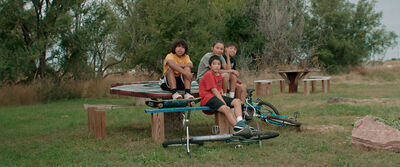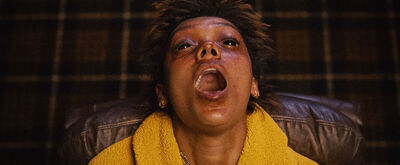Circus Maximus

A surprise feature film is a bit of a contradiction in terms, but it does sometimes happen, with Beyonce’s brilliant anthology “Lemonade” constituting the richest and most fully realized example. Travis Scott‘s “Circus Maximus,” which showed in AMC Theaters as part of a special arrangement with the chain, isn’t in the same weight class. On the qualitative scale of movies that were created mainly to advertise an album of new songs, it’s probably closer to the Beatles’ slapped-together movie “Magical Mystery Tour,” which was broadcast in the United Kingdom on the day after Christmas, 1967; suffice to say that if you’ve never heard of it, there’s a reason. On the other hand, the “Magical Mystery Tour” did give the world the title track and the “All You Need is Love” video, and there’s a case to be made that the mere existence of an odd and basically uncategorizable film like this should be supported and encouraged just because it’s so different from what usually plays in chain theaters.
“Circus Maximus” is credited as having been written and directed by Travis Scott, but it’s an anthology comprised of work by a lot of other directors, including Harmony Korine, Nicolas Winding Refn, Gaspar Noe, and Kahlil Joseph, and you sort of have to guess who directed what until the end credits. By the time you read this, the film will likely no longer be available in theaters, though it’s possible that it could reappear as a one-off curiousity or midnight movie.
The movie begins with a science-fiction-y scene of Scott grappling with a squid-like monster which might represent his own demons (or responsibilities, or both), then eases us into an epic journey montage, with Scott crossing various terrains as if he’s en route to drop a cursed ring into Mt. Doom. His ultimate destination, however, turns out to be the home of a guru-like figure played by producer Rick Rubin. The film periodically returns to their conversations, turning them into a framing device of sorts. The conversations border on incoherent—the discussions about connecting people’s energies and not allowing them to be broken sounds like something a musician would say on a press junket when he’s high and not mad at anybody. These talks are shot with an oval-shaped matte around the image that alternately suggests that the speakers are being surveilled through binoculars or watched by a cyclops (sometimes the image “blinks”).
What follows is a series of music videos, essentially, some better than others, including one shot in Ghana with seemingly hundreds of extras, a sequence directed by Refn in which Scott speeds in a taxi at high speed at night by a creepy crash test dummy driver while calmly smoking weed; “Modern Jam,” a dance floor fantasia co-produced by Daft Punk’s Guy-Manuel de Homem-Christo; and a segment where Scott takes part in a human pyramid in a packed stadium.
Scott must know he’s courting trouble with crowd imagery—eight fans were crushed at one of his 2021 concerts at Houston’s Astroworld, though a Texas grand jury subsequently declined to indict Scott or anyone else associated with the event. It’s also possible that the beast that embraces Scott in the opening is his guilt, fear of consequences, or something along those lines. But the movie is cryptic or coy about such things. While this is as it should be, in what is basically an experimental film, more clarity of purpose (as in “Gimme Shelter,” the Maysles’ Brothers documentary of the Rolling Stones’ disaster at Altamont) might’ve made the material land harder.
Surely not coincidentally, the music videos fall into two categories, crowd or no crowd. The bulk of the film is a concert done without fans, repeating a lot of the same tracks showcased in the music video portion of the film, and unfolding entirely in the eponymous chariot racing stadium in Rome, which also happens to be the site of the single worst disaster in the history of spectator sports: over 1000 people were killed when the venue’s upper tier collapsed. Scott performs mostly solo, although he’s joined at various points by such collaborators as The Weeknd and Swae Lee, The collaborators make their approach from the outer edges of the stadium and are tracked to the center area, often without cuts.
Korine appears to be the person in charge of most of the “concert for nobody” sequences. Like the rest of the movie, this footage is shot on 35mm film, an increasingly rare format, and a lot of it was done from the top of a large crane, which allows for fast sweeping movements that are coded as “epic.” Unfortunately, a lot of this footage is too darkly lit, to the point where you can barely see the performers. And there are also moments where it seems like the camera crew either missed whatever moment or composition they were supposed to be capturing or didn’t know what they were supposed to be focusing on. There’s not much memorable choreography to speak of; much of it is more like bouncing, and the more memorable gestures (such as Scott climbing the huge wall of speakers behind him and perching atop it like Batman) are repeated, which lessens their impact.
Scott is a powerful presence when he’s walking through landscapes and very effective in music videos where he’s silhouetted or wreathed in smoke and strobe lights, but he’s a distant and often cold presence otherwise, especially in conversation scenes with Rubin. He is generally withholding when he’s on-camera, which spells doom for a performer who doesn’t have what could be called, for lack of a better phrase, a film persona (as Prince did). The guest performers generally make a stronger impression even though their screen time is comparatively brief, especially The Weeknd, who has a bit of Mick Jagger’s insouciance (he’s far more charismatic here than he was on HBO’s awful “The Idol“). This is a curiosity and a career footnote more than a substantial freestanding film achievement, which is too bad. It’s more a notion for a work of art than a work of art, and you can’t expect people to pay $25 (the cost of a special engagement ticket opening weekend) for a notion.
In theaters now.










